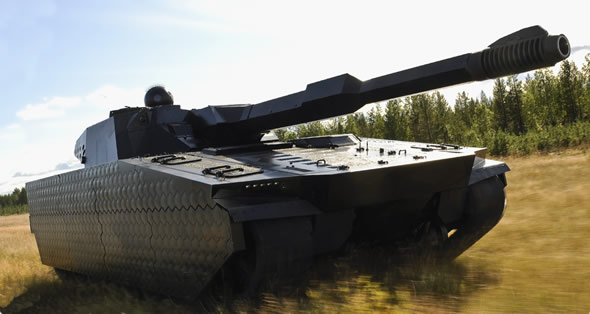
BAE Systems has recently tested an ‘invisibility cloak’ that allows a vehicle to blend into its surroundings, effectively becoming invisible to thermal imaging systems. The company will debut its new technology at the DSEi defense and security expo in London next week.
The system called ‘ADAPTIV’ was developed and patented in Sweden, it operates over infra-red and other frequencies. ADAPTIV can instantly blend the vehicle into the background, reducing detection range below 500 meters. Furthermore, the new technology can also mimic natural objects and other vehicles, and offer cooperative Interrogator Friend/Foe (IFF) capability by displaying distinctive patterns visible only at certain spectral range or in response to an interrogation signal (for example, illumination by coded laser designation).

The system combines sheets of lightweight, hexagonal metallic ‘pixels’ designed to change temperature very rapidly presenting a thermal pattern that optimally blends with its surrounding. Each electrically powered pixel is individually heated or cooled using commercially available semi-conducting technology.

The pattern is determined by an on-board computer feeding from on-board cameras that pick up the background scenery. The system allows even a moving tank to match its surroundings. Alternatively, it can mimic another vehicle or display identification tags, reducing the risk of fratricide.
Project manager, Peder Sjölund explains: “Earlier attempts at similar cloaking devices have hit problems because of cost, excessive power requirements or because they were insufficiently robust. Our panels can be made so strong that they provide useful armor protection and consume relatively low levels of electricity, especially when the vehicle is at rest in ‘stealth reconnaissance’ mode and generator output is low.”
Trials by BAE Systems in mid-July showed that one side of a CV90 could be made effectively invisible or appear to be other objects, including a 4×4 vehicle, when viewed in the infra-red spectrum.”We can resize the pixels to achieve stealth for different ranges.” Sjölund added, “A warship or building, for instance, might not need close-up stealth, so could be fitted with larger panels.” Earlier this year the British media reported about another adaptive camouflage program pursued by BAE Systems, utilizing a kind of electronic ink, to ‘paint’ the background image on the vehicle’s surface.
Current work focuses mainly on the infra-red spectrum, as this is most important to the Swedish Defence Materiel Administration (FMV), which funds part of the work. However, BAE Systems engineers have combined the pixels with other technologies, which provide camouflage in other parts of the electro-magnetic spectrum at the same time to provide all-round stealth, which will be developed further over the next few years.
Combat vehicle protection technologies have evolved dramatically in recent years, moving far beyond traditional ballistic and blast protection, spanning into ‘hit avoidance’ through the use of countermeasures and active protection and signature management, eliminating part of the risk by avoiding detection or target acquisition by enemy weapon systems. Part of the trend of signature management is the use of advanced camouflage, hiding the protected vehicle from visible observation (by advanced camouflage materials) and imaging systems, particularly thermal imagers, which provide the core for most of the modern automated engagement systems (including target acquisition systems and missile seekers).
A similar system is also under development in israel – ‘Invisible Reactive Armor Protection (IRAP)’ utilizing the ‘Blax Fox’ thermal camouflage system from Eltics and IMI’s hybrid armor technology. In the U.S., DARPA and the U.S. Army research and development center have pursued similar capabilities for future spirals of the ‘Manned Ground Vehicle’ – the core maneuver element of the now terminated Future Combat System.



















